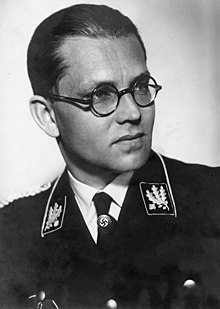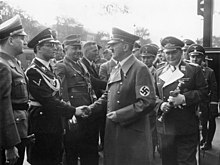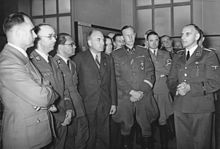Philipp Bouhler
Philipp Bouhler | |
|---|---|
 Bouhler as an SS-Obergruppenführer in 1936 | |
| Reichsleiter | |
| In office 2 June 1933 – 23 April 1945 | |
| Chief of the Chancellery of the Führer of the NSDAP | |
| In office 17 November 1934 – 23 April 1945 | |
| Chief of NSDAP Censorship in the Reichsleitung | |
| In office October 1936 – 23 April 1945 | |
| Chief of Action T4 | |
| In office 1939–1941 | |
| Nazi Party National Business Manager | |
| In office 27 March 1925 – 17 November 1934 | |
| Personal details | |
| Born | 11 September 1899 Munich, Bavaria, German Empire |
| Died | 19 May 1945 (aged 45) Altaussee, Styria, Allied-occupied Austria |
| Cause of death | Suicide |
| Political party | Nazi Party (NSDAP) |
| Other political affiliations | Greater German People's Community |
| Spouse |
Helene Majer
(m. 1934; died 1945) |
| Education | Philosophy |
| Military service | |
| Allegiance | German Empire |
| Branch/service | Imperial German Army |
| Years of service | 1912–1917 |
| Rank | Leutnant |
| Unit | 1st Royal Bavarian Foot Artillery Regiment |
| Battles/wars | |
| Awards | Iron Cross, 2nd class |
Philipp Bouhler (11 September 1899 – 19 May 1945) was a German senior Nazi Party functionary who was both a Reichsleiter (National Leader) and Chief of the Chancellery of the Führer of the NSDAP. He was also the SS official responsible for the Aktion T4 euthanasia program that killed more than 250,000 disabled adults and children in Nazi Germany, as well as co-initiator of Aktion 14f13, also called Sonderbehandlung ('special treatment'), that killed 15,000–20,000 concentration camp prisoners.
Bouhler was arrested on 10 May 1945 by American troops. He committed suicide on 19 May 1945, while in the U.S. internment camp at Zell am See in Austria.[1]
Early life
[edit]Bouhler was born in Munich, to a retired colonel,[2] and spent five years in the Royal Bavarian Cadet Corps. He entered the 1st Royal Bavarian Foot Artillery Regiment in 1916 during the First World War, was commissioned as a Leutnant in July 1917, and was badly wounded the next month. He was awarded the Iron Cross, 2nd class, and was hospitalized through the end of the war.[3] In 1922, he left the University of Munich's philosophy department and became a contributor to the Völkischer Beobachter, the Nazi Party's newspaper.[4]
Nazi functionary
[edit]
Bouhler joined the Nazi Party (NSDAP) in July 1922 with membership number 12. By late 1922 he had become deputy business manager of the NSDAP under Max Amann.[5] He took part in the failed Beer Hall Putsch in Munich and when the Party was banned, became the Business Manager for the Nazi front organization, the Greater German People's Community, based in Munich.[3]
Upon the refounding of the party on 27 February 1925, he immediately rejoined and was made National Business Manager of the NSDAP, holding this post until November 1934.[6] Historian Ian Kershaw avows that because Hitler paid "little attention to administration and organization", he relied on the "indefatigable and subservient" yet "inwardly ambitious" Bouhler and other Party bosses like him.[7] According historian Klaus Fischer, the "owlish looking" Bouhler was part of Adolf Hitler's early inner circle and as a "diffident and punctilious bureaucrat", the Führer could trust him to "carry out any order, no matter how outlandish".[8]
After the seizure of power in 1933, Bouhler was elected as a member of the Reichstag for electoral constituency 18, Southern Westphalia.[9] In June 1933, Hitler appointed him a Reichsleiter, the second highest political rank in the Nazi Party.[10] He joined the SS in the rank of SS-Gruppenführer on 20 April 1933 with membership number 54,932.[1] On 30 January 1936, Bouhler was promoted to the rank of SS-Obergruppenführer.[11]
From the end of August to the end of October 1934, Bouhler was police president of Munich.[6] In September he was made a member of the Academy for German Law. He was next appointed chief of Adolf Hitler's Chancellery, a post specially created on 17 November 1934 that was first and foremost set aside for party business. He held that position until 23 April 1945.[12] In this job, for instance, secret decrees might be prepared, or internal business managed, before being brought before Hitler. An example of such interactions occurred when Bouhler obtained Hitler's written authorization (a rare occurrence) for the expropriation of the villa that became the center of administrative operations for T4, an act veiled in the bureaucracy that characterized Hitler's leadership style.[13][a] Meanwhile, Bouhler was also able to get Hitler to sign the document authorizing the euthanasia program itself and while not possessing the force of law, it provided the necessary protection to get once reluctant physicians to participate.[15] Printed on white stationery bearing the German eagle and swastika with Hitler's name embossed,[b] it read:
Reich Leader Bouhler and Dr. med. Brandt are charged with the responsibility of enlarging the competence of certain physicians, designated by name, so that patients who, on the basis of human judgment, are considered incurable, can be granted mercy death after a discerning diagnosis. (signed) A. Hitler[18]
The euthanasia program's first victims were children registered with conditions like "Down's syndrome, micro- and hydrocephaly, serious physical deformities...and cerebral palsy"; these children were examined by three decision makers (Werner Catel, Hans Heinze, and Ernst Wentzler), who after conferral and agreement,[c] put the child to death.[20] For adults destined for euthanasia, Bouhler and Brandt established "secret-service-style" operations at the Tiergartenstrasse 4 (from whence the program acquired its name) location in Berlin, disguising the murders as medical procedures.[21]

Aside from securing the authorization for the T4 Program and overseeing it, when the plans to ship all of Europe's Jewish population to Madagascar was being proposed during the summer of 1940, Bouhler was designated as the East African colony's future governor.[22][d]
Another of Bouhler's additional duties was to act as chairman of the "Official Party Inspection Commission for the Protection of National Socialist Literature" (Der Chef der Kanzlei des Führers und Vorsitzender der Parteiamtlichen Prüfungskommission zum Schutze des NS-Schrifttums), which determined what writings were and were not suitable for Nazi society.[6] Propaganda minister, Joseph Goebbels was opposed to this writ-large authority granted to Bouhler over all books, a concern he expressed in a personal diary entry from June 1941.[24]
Bouhler's office was responsible for Hitler's correspondence, which included private and internal communications as well as responding to public inquiries (for example, requests for material help, godfathership, jobs, clemency, NSDAP business, and birthday wishes). These types of responsibility and his direct access to Hitler made Bouhler one of the "major players in Hitler's propaganda system".[25] Bouhler's personal adjutant was SS-Sturmbannführer Karl Freiherr Michel von Tüßling. By 1944, many of the Kanzlei des Führers office functions were absorbed by the Party Chancellery (Parteikanzlei) under Martin Bormann, who tried his best to limit all access to Hitler by other party leaders.[26]
Authored work
[edit]Bouhler produced a history of the Nazi movement entitled, Kampf um Deutschland (Fight for Germany) in 1938.[27] Then in 1942, he also published the book "Napoleon – Kometenbahn eines Genies" (Napoleon – A Genius's Cometary Path), which became a favorite of Hitler's.[27][e]
War crimes
[edit]
Bouhler was responsible for the killing of disabled German citizens. By order of Hitler (backdated to 1 September 1939), Bouhler with Karl Brandt developed the Nazis' early euthanasia program, Aktion T4 in which mentally ill and physically disabled people were killed.[28][f] The actual implementation was supervised by Bouhler. Various methods of killing were tried out. The first killing facility was Schloss Hartheim in Upper Austria.[29] Additional euthanasia facilities were established at Bernburg, Grafeneck, Brandenburg, Sonnenstein, and Hadamar between 1940 and 1941,[30] where approximately 70,000 people were murdered in gas chambers using carbon-monoxide.[31][g] The knowledge gained from the euthanasia program was later applied to the industrialized annihilation of other groups of people, especially the Jews.[33]
In 1941, Bouhler and Heinrich Himmler initiated Aktion 14f13.[34] They instructed the head of the Hauptamt II ("main office ll") of Hitler's Chancellery, the Oberdienstleiter Viktor Brack to implement this order.[35] Brack was already in charge of various front operations for the T4 program.[36] The scheme operated under the Concentration Camps Inspector and the Reichsführer-SS under the name "Special Treatment 14f13".[34][h] The combination of numbers and letters was derived from the SS record-keeping system and consists of the number "14" for the Concentration Camps Inspector, the letter "f" for the German word "deaths" (Todesfälle), and the number "13" for the means of killing, in this case, for gassing in the T4 killing centers.[i]
After the war, Brack claimed that in order to keep the euthanasia program personnel employed after it was halted, Bouhler—in conference with Himmler—ordered him "to send the personnel to Lublin...under the supervision of SS-Brigadierführer Globocnik";[j] thereafter, the use of gas chambers for the "specially constructed" Reinhard extermination camps began.[39] During the Nuremberg trials, Brack denied that both his and Bouhler's involvement—despite the fact that the two of them visited Globocnik in Lublin—through the KdF had anything to do with the Final Solution.[40]
Capture and suicide
[edit]Bouhler and his wife, Helene, were arrested by American troops at Schloss Fischhorn in Bruck near Zell-am-See on 10 May 1945. Helene jumped to her death from a window at Schloss Fischhorn. On 19 May, Bouhler killed himself using a cyanide capsule while in the US internment camp at Zell-am-See. The couple had no children.[41]
Awards and Nazi Party decorations
[edit]- Iron Cross 2nd Class (Eisernes Kreuz 2. Klasse) 1914[42]
- Wound Badge (World War I) in Black[42]
- Blood Order[42]
- War Merit Cross 2nd and 1st Class[42]
- Honour Chevron for the Old Guard[43]
See also
[edit]Notes
[edit]- ^ Bouhler took control over the Aktion T4 initiative from Dr. Leonardo Conti, who Hitler originally asked to head the program.[14]
- ^ German historian Peter Longerich clarifies that this was Hitler's "personal writing paper".[16] Recent biographer of Hitler, Volker Ullrich, called this stationery "Hitler's personal letterhead".[17]
- ^ That agreement was reached by simply checking a "plus or minus sign to indicate whether the particular child was to die or be allowed to live."[19] According to historian Doris Bergen, the participating doctors "never saw the children whose fates they decided."[19]
- ^ Bouhler was also asked by Brack—via an inquiry from Himmler—to check with the array of doctors and scientists working in the euthanasia program if it was feasible to sterilize the Jews en masse using X-rays.[23]
- ^ During the war, Bouhler published Der großdeutsche Freiheitskampf ("the greater German freedom struggle"), an edited three volume series featuring the speeches given by Hitler from 1 September 1939, to 15 March 1942. See for instance: https://archive.org/details/Bouhler-Philipp-Der-grossdeutsche-Freiheitskampf-3 ; https://archive.org/details/Bouhler-Philipp-Der-grossdeutsche-Freiheitskampf ; https://archive.org/details/dergrossdeutsche00hitl
- ^ View the following website for more information: "The 'euthanasia" crime in Hadamar" Archived 12 June 2011 at the Wayback Machine University of Minnesota, Center for Holocaust and Genocide Studies. Retrieved 17 May 2010.
- ^ Once the victims were murdered, their gold teeth were extracted and the bodies cremated.[32]
- ^ Sonderbehandlung ("special treatment") was the euphemistic term for execution or killing.[37]
- ^ Historian Henry Friedlander writes that "14f included all files involving the death of prisoners. Thus, for example, 14f7 files concerned death through natural causes, 14f8 applied to suicides, and 14f14 involved executions".[34]
- ^ Historian Michael Burleigh wrote that some "ninety-two T4 personnel were made available by Bouhler" to Globocnik.[38]
References
[edit]- ^ a b Miller 2006, p. 155.
- ^ Klee 2016, p. 67.
- ^ a b Williams 2015, p. 147.
- ^ USHMM, "Nazi Party organizes Voelkischer Beobachter".
- ^ Miller 2006, pp. 155, 160.
- ^ a b c Wistrich 1995, p. 20.
- ^ Kershaw 1999, p. 300.
- ^ Fischer 1995, p. 195.
- ^ Williams 2015, p. 148.
- ^ Zentner & Bedürftig 1991, p. 103.
- ^ Miller 2006, p. 156.
- ^ Miller 2006, p. 157.
- ^ Cesarani 2016, pp. 282–283.
- ^ Fischer 1995, p. 389.
- ^ Friedlander 1995, pp. 66–67.
- ^ Longerich 2019, p. 671.
- ^ Ullrich 2020, p. 244.
- ^ Friedlander 1995, p. 67.
- ^ a b Bergen 2009, p. 127.
- ^ Weale 2012, pp. 177–178.
- ^ Weale 2012, p. 179.
- ^ Longerich 2019, pp. 700–702.
- ^ Browning 2004, p. 106.
- ^ Bytwerk 2004, p. 65.
- ^ Bytwerk 2004, p. 58.
- ^ Orlow 2010, p. 221.
- ^ a b Zentner & Bedürftig 1991, p. 104.
- ^ Miller 2006, p. 158.
- ^ Friedlander 1995, pp. 86–92.
- ^ Hilberg 1985, p. 226.
- ^ Heinemann 2018, p. 507.
- ^ Friedländer 2009, p. 151.
- ^ Black 2016, pp. 35, 54–56.
- ^ a b c Friedlander 1995, p. 142.
- ^ Friedlander 1995, pp. 142–143.
- ^ Friedlander 1995, pp. 40–41, 68–69, 72, 78.
- ^ Yahil 1990, p. 309.
- ^ Burleigh 1997, p. 127.
- ^ Stone 2023, p. 192.
- ^ Friedlander 1994, p. 54.
- ^ Miller 2006, pp. 155, 159–160.
- ^ a b c d Miller 2006, p. 159.
- ^ Miller 2006, p. 160.
Bibliography
[edit]- Bergen, Doris (2009). War & Genocide: A Concise History of the Holocaust (Second, revised ed.). Lanham, MD: Rowman & Littlefield. ISBN 978-0-7425-5715-4.
- Black, Jeremy (2016). The Holocaust: History and Memory. Bloomington; Indianapolis: Indiana University Press. ISBN 978-0-25302-214-1.
- Browning, Christopher R. (2004). The Origins of the Final Solution: The Evolution of Nazi Jewish Policy, September 1939 – March 1942. Lincoln: University of Nebraska Press. ISBN 0-8032-1327-1.
- Burleigh, Michael (1997). Ethics and Extermination: Reflections on Nazi Genocide. Cambridge; New York: Cambridge University Press. ISBN 978-0-52158-816-4.
- Bytwerk, Randall L. (2004). Bending Spines: The Propagandas of Nazi Germany and the German Democratic Republic. East Lansing, MI: Michigan State University Press. ISBN 978-0870137105.
- Cesarani, David (2016). Final Solution: The Fate of the Jews, 1933–1945. New York: St. Martin’s. ISBN 978-1-25000-083-5.
- Fischer, Klaus (1995). Nazi Germany: A New History. New York: Continuum. ISBN 978-0-82640-797-9.
- Friedlander, Henry (1994). "Euthanasia and the Final Solution". In David Cesarani (ed.). The Final Solution: Origins and Implementation. London and New York: Routledge. ISBN 978-0-41515-232-7.
- Friedlander, Henry (1995). The Origins of Nazi Genocide: From Euthanasia to the Final Solution. Chapel Hill: University of North Carolina Press. ISBN 978-0-80782-208-1.
- Friedländer, Saul (2009). Nazi Germany and the Jews, 1933–1945. New York: Harper Perennial. ISBN 978-0-06135-027-6.
- Heinemann, Isabel (2018). "Race". In Shelley Baranowski; Armin Nolzen; Claus‐Christian W. Szejnmann (eds.). A Companion to Nazi Germany. Hoboken, NJ; West Sussex: Wiley-Blackwell. ISBN 978-1-11893-688-7.
- Hilberg, Raul (1985). The Destruction of the European Jews. New York: Holmes & Meier. ISBN 0-8419-0910-5.
- Kershaw, Ian (1999). Hitler: 1889–1936, Hubris. New York: W. W. Norton & Company. ISBN 978-0-39304-671-7.
- Klee, Ernst (2016). Personenlexikon zum Dritten Reich: Wer war was vor und nach 1945 (in German). Hamburg: Nikol Verlag. ISBN 978-3-86820-311-0.
- Longerich, Peter (2019). Hitler: A Biography. Oxford and New York: Oxford University Press. ISBN 978-0-19005-673-5.
- Miller, Michael (2006). Leaders of the SS and German Police, Vol. 1. San Jose, CA: R. James Bender. ISBN 978-93-297-0037-2.
- Orlow, Dietrich (2010). The Nazi Party 1919–1945: A Complete History. New York: Enigma Books. ISBN 978-1-92963-157-5.
- Stone, Dan (2023). The Holocaust: An Unfinished History. New York and Boston: Mariner Books. ISBN 978-0-06334-903-2.
- Ullrich, Volker (2020). Hitler: Downfall, 1939–1945. New York: Knopf. ISBN 978-1-10187-400-4.
- USHMM. "Nazi Party organizes; "Voelkischer Beobachter" office; newspapers; leading officials". United States Holocaust Memorial Museum—Holocaust Encyclopedia. Retrieved 7 September 2024.
- Weale, Adrian (2012). Army of Evil: A History of the SS. New York: Caliber Printing. ISBN 978-0451237910.
- Williams, Max (2015). SS Elite: The Senior Leaders of Hitler's Praetorian Guard. Vol. I. Fonthill Media LLC. ISBN 978-1-78155-433-3.
- Wistrich, Robert (1995). Who's Who In Nazi Germany. New York: Routledge. ISBN 978-0-41511-888-0.
- Yahil, Leni (1990). The Holocaust: The Fate of European Jewry, 1932–1945. Oxford and New York: Oxford University Press. ISBN 0-19-504522-X.
- Zentner, Christian; Bedürftig, Friedemann (1991). The Encyclopedia of the Third Reich. (2 vols.) New York: MacMillan Publishing. ISBN 0-02-897500-6.
{{cite book}}: CS1 maint: location (link)
External links
[edit]- 1899 births
- 1945 suicides
- 1945 deaths
- Aktion T4 personnel
- German Army personnel of World War I
- German police chiefs
- Greater German People's Community politicians
- Members of the Academy for German Law
- Members of the Reichstag 1933
- Militant League for German Culture members
- Nazis who died by suicide in prison custody
- Prisoners who died in United States military detention
- Nazis who participated in the Beer Hall Putsch
- People from Munich
- Recipients of the Iron Cross (1914), 2nd class
- Recipients of the War Merit Cross
- Reichsleiters
- SS-Obergruppenführer
- Suicides by cyanide poisoning
- Nazis who died by suicide in Austria
- German prisoners of war in World War II held by the United States
- Members of the Reichstag 1933–1936
- Members of the Reichstag 1936–1938
- Members of the Reichstag 1938–1945
